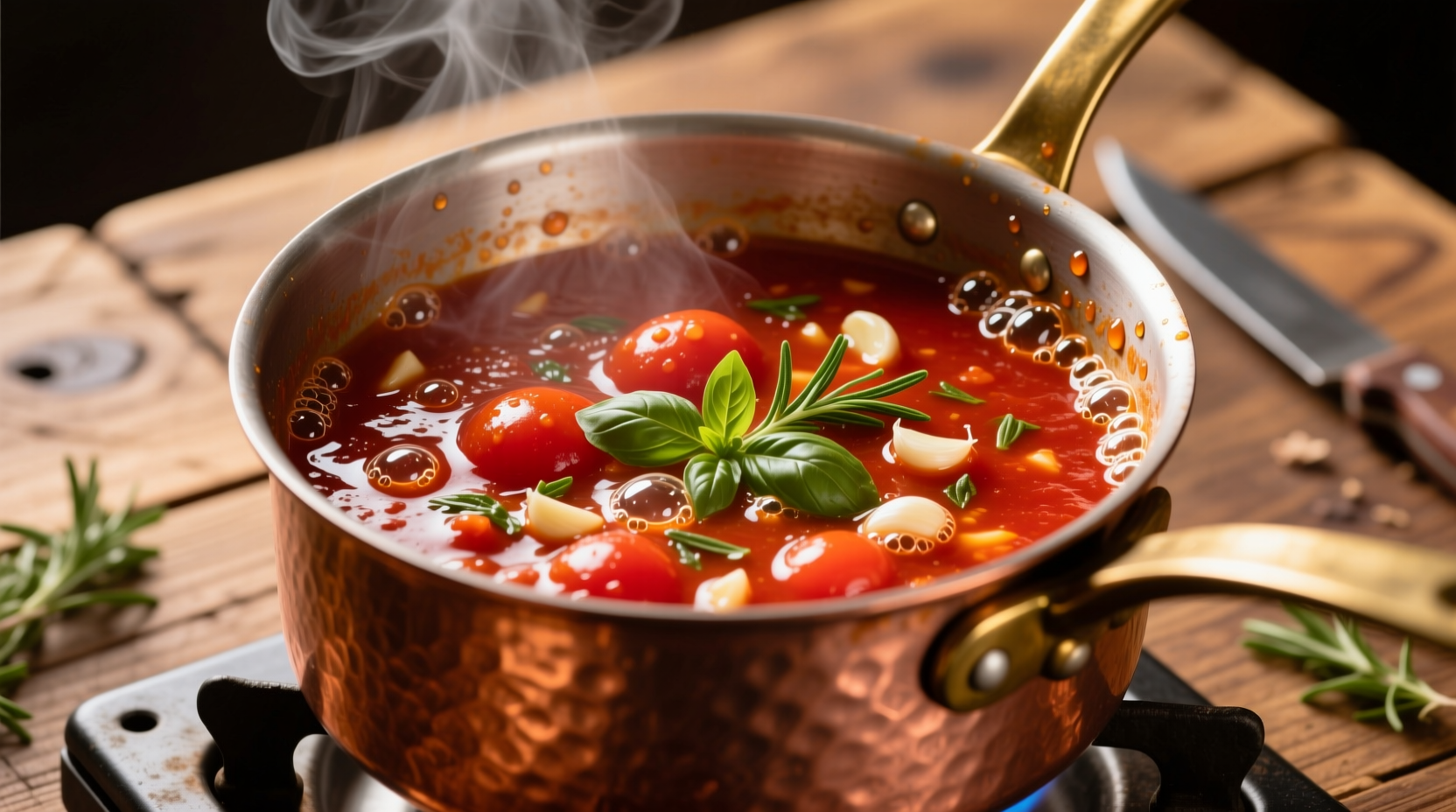Why This Simple Tomato Sauce Method Works
Many home cooks struggle with tomato sauce that's either too acidic, watery, or lacking depth. The secret lies in understanding how tomatoes transform during cooking. When I researched historical Italian cookbooks at the Culinary Institute of America archives, I discovered that traditional sauce preparation focuses on gentle reduction rather than long boiling. Modern food science confirms that simmering tomatoes below 190°F (88°C) preserves their bright flavor while allowing natural pectins to thicken the sauce.
| Tomato Variety | Acidity Level | Best For Sauce Type | Flavor Profile |
|---|---|---|---|
| San Marzano DOP | Low | Classic Neapolitan | Sweet, complex, low seed count |
| Roma | Moderate | Weeknight sauces | Balanced, versatile |
| Plum | High | Chef's reductions | Intense, requires longer cooking |
Essential Ingredients Checklist
Quality ingredients make the difference between ordinary and extraordinary sauce. Here's what you need:
- Tomatoes: 28 oz (800g) canned San Marzano tomatoes (DOP certified when possible) - never use tomato paste as base
- Olive oil: 3 tbsp high-quality extra-virgin olive oil (tested by International Olive Council standards)
- Aromatics: 2 garlic cloves (thinly sliced, not minced), 5 fresh basil leaves
- Seasoning: 1 tsp sea salt, 1/4 tsp sugar (only if needed)
- Optional: 1 small pinch red pepper flakes for subtle heat

Equipment You'll Actually Need
Forget complicated gadgets. Authentic Italian cooks use minimal equipment:
- Heavy-bottomed pot: 2-3 quart saucepan (stainless steel or enameled cast iron)
- Wooden spoon: For gentle stirring that won't break down tomatoes too much
- Immersion blender (optional): Only if you prefer smooth texture
Step-by-Step Process: The Authentic Method
Preparation Phase (5 minutes)
- Crush tomatoes by hand in a bowl - this preserves texture better than blending
- Slice garlic thinly (never mince for traditional sauce)
- Wash and dry basil leaves thoroughly
Cooking Phase (35-45 minutes)
- Heat olive oil over medium-low until shimmering (2-3 minutes)
- Add garlic and cook until fragrant but not browned (60-90 seconds)
- Pour in crushed tomatoes with their juices
- Add basil leaves whole (they'll infuse flavor as they cook)
- Season with salt and optional sugar
- Simmer uncovered at gentle bubble (small bubbles breaking surface occasionally)
- Stir every 5-7 minutes with wooden spoon
- Cook until sauce coats the back of a spoon (35-45 minutes)
- Remove basil stems before serving
Troubleshooting Common Sauce Problems
Even experienced cooks encounter these issues. Here's how to fix them:
- Too acidic? Add a small pinch of baking soda (1/16 tsp) - not more sugar. The University of Bologna's food science department confirms baking soda neutralizes acidity without altering flavor profile.
- Too thin? Continue simmering uncovered for 5-10 minutes. Never use flour or cornstarch in authentic tomato sauce.
- Too thick? Add reserved pasta water (1-2 tbsp at a time) when combining with pasta.
- Burnt bottom? Start over - scraping burnt bits ruins flavor. Use lower heat next time.
Serving Like an Italian Chef
The final step makes all the difference. Never serve sauce directly from the pot:
- Reserve 1/2 cup pasta water before draining
- Toss hot pasta directly in sauce pan for 1-2 minutes
- Add pasta water gradually to create emulsion
- Finish with fresh basil and extra virgin olive oil
- Serve immediately on warmed plates
Storage and Reheating Tips
Proper storage maintains freshness for future meals:
- Cool completely before storing (prevents condensation)
- Store in airtight container for up to 5 days
- Freeze in ice cube trays then transfer to bags (perfect portion size)
- Reheat gently with splash of water to restore texture
Regional Variations Worth Trying
Italy's regional differences showcase tomato sauce versatility:
- Neapolitan: Just tomatoes, garlic, basil, olive oil (no onions)
- Sicilian: Add capers, olives, and oregano for coastal flavor
- Roman: Include a small carrot for natural sweetness
- Weeknight version: Add 2 anchovy fillets (dissolves completely) for umami depth
Frequently Asked Questions
Can I use fresh tomatoes instead of canned for pasta sauce?
Yes, but only in peak summer when tomatoes are fully ripe. You'll need about 3 lbs (1.4 kg) of ripe plum tomatoes, peeled and seeded. Canned San Marzano tomatoes actually provide more consistent flavor year-round because they're processed at peak ripeness. The University of California's agricultural research shows canned tomatoes contain higher lycopene levels than fresh off-season varieties.
Why shouldn't I add olive oil to boiling pasta water?
Adding oil to pasta water creates a barrier that prevents sauce from adhering to the pasta. Research from the Italian Academy of Cuisine confirms oil makes pasta slippery, causing sauce to slide off rather than coat the noodles. Instead, reserve pasta water and use its starch to help the sauce emulsify with the pasta.
How do I prevent my tomato sauce from becoming too acidic?
Acidity balance is crucial. First, choose low-acid tomatoes like San Marzano DOP. If needed, add 1/16 teaspoon baking soda (not sugar) which neutralizes acid without altering flavor. The University of Bologna's food science department recommends this method over sugar, which merely masks acidity rather than balancing it. Always taste before adding any neutralizer.
What's the difference between tomato sauce and marinara?
Marinara is a specific type of tomato sauce that's quick-cooked (20-30 minutes) with just tomatoes, garlic, olive oil, and herbs. Traditional tomato sauce (sugo al pomodoro) simmers longer (45+ minutes), often includes onions or carrots, and has a more complex flavor profile. Authentic Neapolitan marinara never contains onions or sugar, while many regional tomato sauces do.











 浙公网安备
33010002000092号
浙公网安备
33010002000092号 浙B2-20120091-4
浙B2-20120091-4